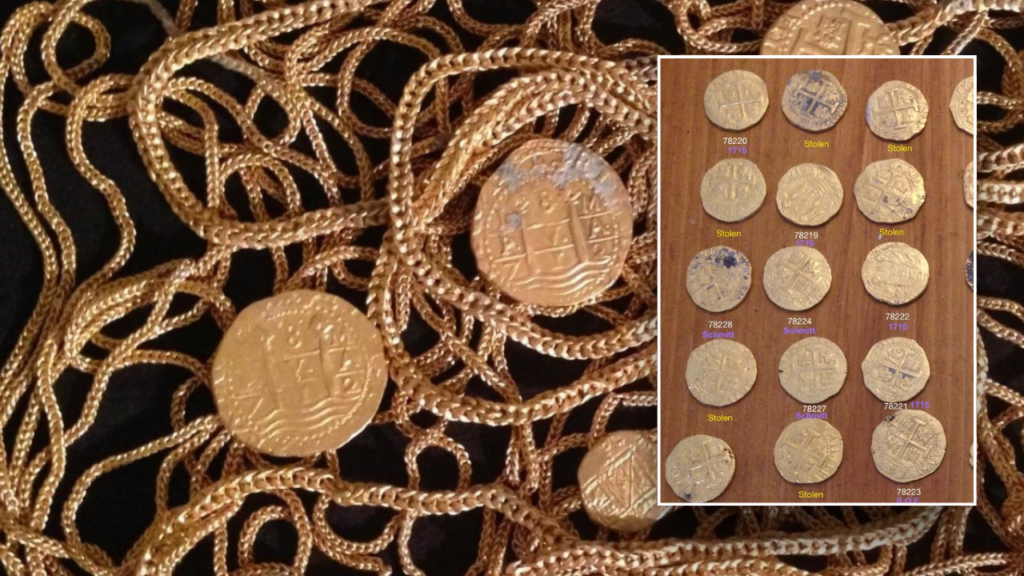The recent announcement by Florida authorities regarding the recovery of centuries-old gold coins, which had been stolen in 2015, has sparked considerable interest among historians, treasure hunters, and the general public alike. The Florida Fish and Wildlife Conservation Commission (FWC) revealed that, thanks to the collaborative efforts with the Federal Bureau of Investigation (FBI), a total of 37 gold coins were successfully recovered, holding a significant collective value of approximately $1 million.
These gold coins trace their origins back to the fabled 1715 Treasure Fleet. This fleet comprised several Spanish ships that met with a tragic fate during a catastrophic hurricane in July of that year. The tempestuous weather caused numerous vessels to sink off the coast of Florida, leading to considerable treasure being lost to the depths of the ocean. Fast forward exactly 300 years, in 2015, a monumental discovery was made by the Schmitt family, which found a trove of 101 gold coins while exploring the waters off Florida’s aptly named Treasure Coast. This family operated an LLC named 1715 Fleet – Queens Jewels and was at the forefront of what many hoped would be a journey toward historical preservation and financial recovery from the spoils of the past.
Although 51 of the coins were eventually accounted for and properly adjudicated, the whereabouts of the remaining coins remained a mystery. The FWC categorized the absence of these 50 coins as theft. In a statement, they expressed the gravity of the situation, highlighting the importance of the stolen artifacts and the efforts needed to recover them.
The investigation took a more definitive turn in the summer of 2023, when the FWC formally began collaborating with the FBI to probe into the actions of Eric Schmitt, who came to be associated with the unauthorized transactions of several stolen gold coins during 2023-2024. As part of a rigorous investigation, investigators executed numerous search warrants, leading to the recovery of coins from various locations, including private homes, safe deposit boxes, and auctions.
One noteworthy recovery involved five coins that were traced back to a Florida-based auctioneer. Unfortunately, the auctioneer had unwittingly acquired these coins from Eric Schmitt, who had been directly linked to their illicit sale. Furthermore, advanced digital forensic techniques helped point investigators to crucial metadata and geolocation data, directly connecting Schmitt to a photograph of the stolen coins taken at his family’s condominium in Fort Pierce, thereby reinforcing the case against him.
Adding a bizarre twist to this story, the FWC indicated that in 2016, Schmitt had taken three stolen coins and deliberately placed them back into the ocean. This seemingly unusual act was purportedly aimed at providing the new investors of 1715 Fleet – Queens Jewels, LLC, with the impression that they had found the coins as part of their treasure-hunting endeavors.
Despite the successful recovery of 37 coins, a total of 13 coins still remain unaccounted for. The FWC articulated that this recovery triumph not only signifies the culmination of extensive investigation but represents a pivotal moment in the ongoing struggle against the theft and illicit trafficking of invaluable historical artifacts. The sentiment echoed by the FWC captured the collective gratitude toward the various investigative teams, law enforcement partners, and forensic experts whose collaborative efforts made this case a landmark achievement.
As the investigation continues, many eyes remain on the FWC and the FBI, hopeful that the remaining stolen treasures will also be recovered. The saga of the 1715 Treasure Fleet stands as a stark reminder of the enduring intrigue surrounding treasure hunting and the lengths some might go to reclaim their land’s rich history. Through such efforts, both history and heritage may ultimately be preserved for future generations.



